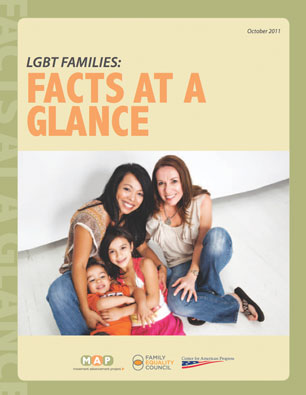The Bottom Line
LGBT Families: Facts at a Glance is a short companion document to All Children Matter: How Legal and Social Inequalities Hurt LGBT Families. It features key data from the Full Report via easy-to-navigate charts, tables and maps examining key population data on LGBT families; snapshots of how laws in various states hurt children with LGBT parents; summaries of ways in which children raised in LGBT families fall through safety net programs; summaries of ways in which LGBT families face healthcare disparities, unwelcoming health care environments and restrictions in providing care to each other; and more.
LGBT Families: Facts at a Glance Download
Also available: the Full Report, Condensed Version and Executive Summary of All Children Matter.
Recommended citation:Movement Advancement Project, Family Equality Council, and Center for American Progress. October 2011.
LGBT Families: Facts at a Glance. https://www.lgbtmap.org/lgbt-families-facts-at-a-glance (date of access).


